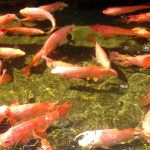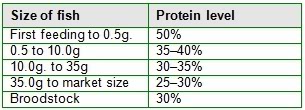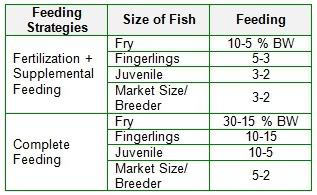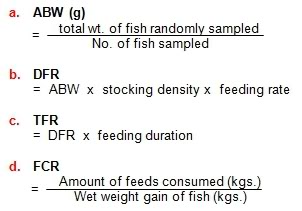
 Tilapias are also daytime and surface feeder. It means they eat at the water surface and eat more during the day. At night there is little or no feeding activity. Protein Requirement
Tilapias are also daytime and surface feeder. It means they eat at the water surface and eat more during the day. At night there is little or no feeding activity. Protein Requirement  Tilapias are able to utilize below the optimum and still produce good growth. The use of sub-optimal protein levels in tilapia feeds will lower feed costs and improve economics. Forms/ Types of Feeds 1. Mash or powder form This is given to fish weighing less than 0.2g. to 5.0g./pc. This is known as the fry mash 2. Crumbles This is given to fish weighing 5.1g. to 30.0g./pc. This is also known as the starter crumble. 3. Pellets This is given as soon as the mouth of fish is big enough to swallow the smallest size of pellet. a. Juvenile Pellet. This is known as the grower pellet. It is given to fish weighing 30.1 to 90.0g./pc. b. Adult Pellet. This is known as the finisher pellet. It is given to fish weighing greater than 90.0g./pc. 4. Dough or ball form It is prepare by adding water to the feed while mixing until sticky mass is formed. In the absence of pelleting machine, feed maybe prepared in this manner. Pellet Size Tilapias prefer smaller pellets and dislike hard pellets. As a rule of thumb, small fish should be provided with small feed particles while large fish should be provided with large feed particles. Feeding Ratio It is the amount of feed being fed daily to the fish. It is also expressed as percentage of fish biomass.
Tilapias are able to utilize below the optimum and still produce good growth. The use of sub-optimal protein levels in tilapia feeds will lower feed costs and improve economics. Forms/ Types of Feeds 1. Mash or powder form This is given to fish weighing less than 0.2g. to 5.0g./pc. This is known as the fry mash 2. Crumbles This is given to fish weighing 5.1g. to 30.0g./pc. This is also known as the starter crumble. 3. Pellets This is given as soon as the mouth of fish is big enough to swallow the smallest size of pellet. a. Juvenile Pellet. This is known as the grower pellet. It is given to fish weighing 30.1 to 90.0g./pc. b. Adult Pellet. This is known as the finisher pellet. It is given to fish weighing greater than 90.0g./pc. 4. Dough or ball form It is prepare by adding water to the feed while mixing until sticky mass is formed. In the absence of pelleting machine, feed maybe prepared in this manner. Pellet Size Tilapias prefer smaller pellets and dislike hard pellets. As a rule of thumb, small fish should be provided with small feed particles while large fish should be provided with large feed particles. Feeding Ratio It is the amount of feed being fed daily to the fish. It is also expressed as percentage of fish biomass.  Feeding rates are affected by water temperature. Fish of all size eat less and stop taking feed as water decreases or increases beyond their optimum range. Optimum production temperature is approximately 28 degree Celsius with a range between 25-30 degree Celsius. Feeding Schedule It refers to the specific time and frequency at which the feed allowance is given to the fish.
Feeding rates are affected by water temperature. Fish of all size eat less and stop taking feed as water decreases or increases beyond their optimum range. Optimum production temperature is approximately 28 degree Celsius with a range between 25-30 degree Celsius. Feeding Schedule It refers to the specific time and frequency at which the feed allowance is given to the fish.  Tilapias are suited to deal with regular supplies of food or little and often. Feeding Method 1. Hand feeding (Sabog) Feed is distributed evenly or in several sites so that all fish have access to food. 2. Using feeding bag Feed is placed in a B-net (32 mm mesh size) feeding bag and tied in poles. The bag is suspended in pond water surface. Fish obtain feeds by picking or suction. Determination of Average Body Weight (ABW), Daily Feed Ration (DFR), Total Feed Requirement (TFR) and Feed Conversion Ratio (FCR)
Tilapias are suited to deal with regular supplies of food or little and often. Feeding Method 1. Hand feeding (Sabog) Feed is distributed evenly or in several sites so that all fish have access to food. 2. Using feeding bag Feed is placed in a B-net (32 mm mesh size) feeding bag and tied in poles. The bag is suspended in pond water surface. Fish obtain feeds by picking or suction. Determination of Average Body Weight (ABW), Daily Feed Ration (DFR), Total Feed Requirement (TFR) and Feed Conversion Ratio (FCR)  The closer the FCR to 1.0 kg. The better is the feed. Good feeds have FCR's of between 1.5 to 2.0 kg. Pointers in Fish Feeding 1. Always feed the fish at the same time and in the same part of the pond. Fish will learn where to go to get their food. 2. Do not overfeed. Too much food will not be eaten but will decay and will use up oxygen during decaying process. 3. Monitoring the dissolved oxygen of the pond regularly. Ponds with low DO concentrations, fish will eat less and they will not convert food to flesh efficiency. 4. Do not feed the fish for about 24 hrs. before harvesting or transporting. When the fish eat, they void the waste into the water. Combination of food and wastes makes the water turbid and increases the stress that is already placed on fish by the breeding and harvesting process. 5. Always have routinary pond cleaning and stock inventory. Aquatic macrophytes remove inorganic nutrients and limit phytoplankton growth. 6. Keep daily records of feeds given and of fish mortality. It would determine the efficiency of a feeding program and would help one to interpret if the business was successful or not. 7. Avoid overstocking the pond. It deteriorates water quality, increase metabolic waste build up and lead to poor utilization of supplemental feeds. For more information please call or write to: The Project Manager BFAR-NFFTC CLSU, Muñoz, Nueva Ecija Tele-Fax no. (044) 4560-670 E-mail address: nfftc@bfar.da.gov.ph Source: nfrdi.da.gov.ph
The closer the FCR to 1.0 kg. The better is the feed. Good feeds have FCR's of between 1.5 to 2.0 kg. Pointers in Fish Feeding 1. Always feed the fish at the same time and in the same part of the pond. Fish will learn where to go to get their food. 2. Do not overfeed. Too much food will not be eaten but will decay and will use up oxygen during decaying process. 3. Monitoring the dissolved oxygen of the pond regularly. Ponds with low DO concentrations, fish will eat less and they will not convert food to flesh efficiency. 4. Do not feed the fish for about 24 hrs. before harvesting or transporting. When the fish eat, they void the waste into the water. Combination of food and wastes makes the water turbid and increases the stress that is already placed on fish by the breeding and harvesting process. 5. Always have routinary pond cleaning and stock inventory. Aquatic macrophytes remove inorganic nutrients and limit phytoplankton growth. 6. Keep daily records of feeds given and of fish mortality. It would determine the efficiency of a feeding program and would help one to interpret if the business was successful or not. 7. Avoid overstocking the pond. It deteriorates water quality, increase metabolic waste build up and lead to poor utilization of supplemental feeds. For more information please call or write to: The Project Manager BFAR-NFFTC CLSU, Muñoz, Nueva Ecija Tele-Fax no. (044) 4560-670 E-mail address: nfftc@bfar.da.gov.ph Source: nfrdi.da.gov.phSource: Business Diary Philippines



0 Comments